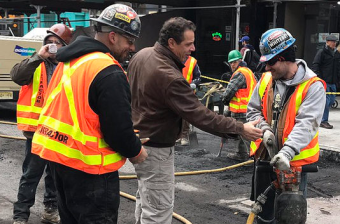What We Know So Far About Cuomo’s MTA Reinvention Commission
In early May, Governor Andrew Cuomo directed the MTA to create a “transportation reinvention” panel as the authority prepared its next five-year capital plan. Members were appointed late last month, and the commission has launched Facebook and Twitter accounts. But details about its agenda and how open it will be to the public are scant. Meanwhile, the clock is ticking: The MTA capital plan has to be finalized by October 1.

The MTA says it will announce public meetings by the end of this week, and commission members say those sessions are likely to happen next week, just days after being announced. Beyond that, things are hazy: There is no agenda for future commission meetings and no schedule for reporting the commission’s recommendations.
The 24-member panel, chaired by former US DOT Secretary Ray LaHood and former FAA Administrator Jane Garvey, is being advised by MTA staff as well as mega-consultant Parsons Brinckerhoff, which is already working on the Fulton Street Transit Center, East Side Access, Second Avenue Subway, and 7 train extension to Hudson Yards — all of which are in various states of budget overrun or delay.
Advocates on the commission say it’s off to a good start, however, and they’re optimistic about what will emerge from the process.
The panel met for the first time late last month and members have been broken into five subcommittees:
- Operating and Maintaining the Existing System
- Meeting and Exceeding Customer Needs
- Spurring the Continued Growth of New York’s Economy
- Financing Investments into the Future
- Expediting Processes, Procedures and Project Delivery of Capital Infrastructure
The subcommittees, which have weighty issues to consider, have each met at least once, sometimes via conference call. Veronica Vanterpool, executive director of the Tri-State Transportation Campaign, says members haven’t been afraid to think big. “Many of us are taking it to heart that this is a reinvention commission, and that things that have not been discussed before really should be on the table going forward, even if they’re just ideas,” she said. “It’s sort of rethinking our transportation network in this region.”
“The whole thing feels like it has more energy than the typical fare or service hearing,” said commission member Gene Russianoff of NYPIRG’s Straphangers Campaign. “I’m hoping the commission finds a serious way to get people to think along with it about how we improve on transit.”
How that will happen remains to be seen, even to commission members. “It’s hard to talk specifics,” Vanterpool said. “I’m assuming this is going to be due this summer, but I don’t have any firm dates.”
“The commission hasn’t yet established a specific date by which it expects to conclude and/or report its work,” said MTA spokesperson Aaron Donovan. There is one final deadline: The MTA will submit its five-year capital plan to the governor and the legislature by October 1.
The MTA reinvention commission isn’t the first transit panel created in New York state, but the three most recent examples all had more time to deliberate publicly and come up with recommendations than the MTA reinvention commission.
In July 2007, the Traffic Congestion Mitigation Commission was created to study congestion pricing after Mayor Bloomberg’s proposal was introduced in the legislature the month before. The 17-member commission, selected by Governor Spitzer, legislative leaders, Mayor Bloomberg, and Speaker Christine Quinn, was appointed that summer and began meeting in September, tasked with making a recommendation in January 2008.
Between September and January, the congestion pricing commission met seven times and held 13 public hearings, gathering testimony in all five boroughs, Westchester County, and Long Island.
While the congestion pricing plan supported by the commission ultimately failed a few months later in the Assembly, similar issues came up again later in 2008 with the Ravitch Commission, created to address the MTA’s capital and operating finances just as the economic tailspin was wreaking havoc with the authority’s budget.
The 14-member commission, appointed by Governor David Paterson in June 2008 and chaired by former MTA chair Richard Ravitch, met seven times, including three public hearings in Manhattan, Westchester, and Long Island, before releasing its final report that December.
The most recent transit-related panel was convened by Governor Cuomo. In August 2012, county executives backed his Tappan Zee Bridge project in exchange for study groups on tolls and transit. While the toll task force has yet to materialize nearly two years later (a re-election campaign is underway, after all), the Thruway Authority announced the 28-member transit task force that December.
Nearly 15 months after its first meeting, the transit task force released its final report in February 2014. Along the way, it held 12 meetings, with 10 of those open to the public and eight accepting public comment.
Compared to the leisurely pace of the Tappan Zee transit task force, if the reinvention commission is going to have an impact on the MTA’s capital plan or its increasingly debt-dependent finances, it’s going to have to act fast.
